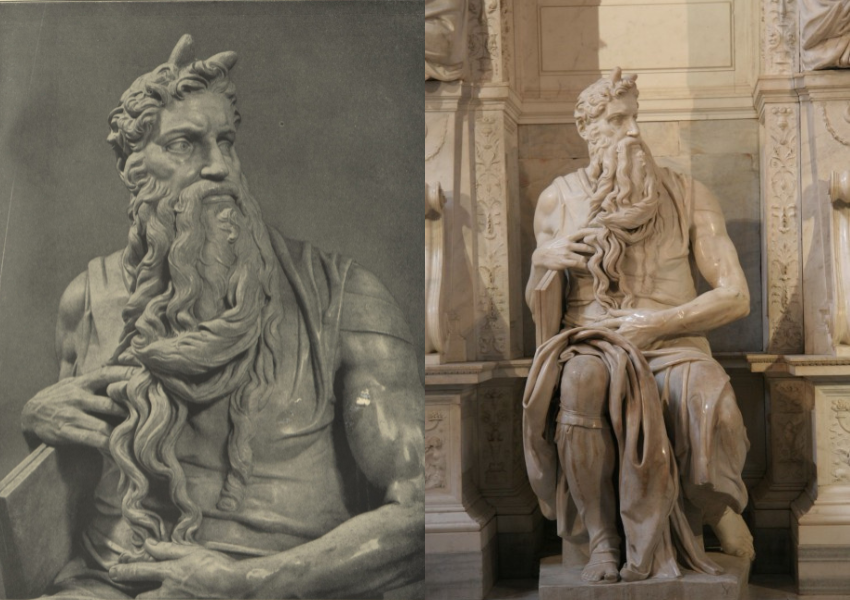Freud, the Godfull Jew. (Part 1/6)

Above: Left: Moses by Michelangelo, 1513-15. Image is the frontispiece from Freud’s essay. Right: Moses by Michelangelo located in San Pietro in Vincoli, Rome. Source: Wikimedia Commons.
Freud’s essay “The Moses of Michelangelo” (1914) is his most misunderstood essay. It contains so many subterranean labyrinths of myth, metaphor, literature, and religion that it almost feels impossible to contain all its implications. It is an essay profoundly dealing with the question of mysticism, on whether “signs” can be revealed from outside the psyche or generated within the psyche. Much ink has been spilled on Freud’s relationship to mystical Judaism, and this essay sits at the center of that conversation.
Freud, the Godfull Jew. (Part 2/6)

Above: Illustrations for Freud’s “Der Moses,” Imago 3.1 (1914).
Freud’s visual demonstration is contained in the four illustrations of Michelangelo’s famous statue of Moses he included in the essay, in which Freud gives readers strict instructions for how to reconstruct the illustrations. The purpose of the essay and its illustrations is to demonstrate how memory stores partial perspectives (visual signs) as whole.
Doubling his typographical “signs” (>> << and ***) into directives for action throughout the text, Freud shows his readers how individual memory encodes “thing-presentations” (as opposed to word-presentations). According to Freud, a “thing-presentation” is the duplication of a perceptual sign into a flipped-over doppelganger that is then merged into a single “whole” in the unconscious memory. If we follow Freud’s instructions and gently push each of the four images towards their “doppelganger” (its flipped-over pair), we will see the frontal face of Moses from the three different and mutually exclusive perspectives that the discipline or art has professed about this statue.
Freud, the Godfull Jew. (Part 3/6)

Above: “The Prophet.” Reconstruction of Sigmund Freud, Illustration 1. for “Der Moses,” Imago 3, no. 1 (1914)
When this procedure is followed with the Illustration 1, one sees from this position of Moses the Prophet, which falls in line with Freud’s review of art historical conclusions in the previous section of the essay. Freud cites to Fritz Knapps’ heroic visionary of the “huge frame” of Thode’s “Titan” and “superman,” Steinmann’s “royal priest,” whose “proud head” Herman Grimm saw “carried high on his shoulders.” Thus, in Freud’s paper puzzle, we see the HERO-Prophet.
Freud, the Godfull Jew. (Part 4/6)

Above: “The Satyr.” Reconstruction of Sigmund Freud, Illustration 2. for “Der Moses,” Imago 3, no. 1 (1914)
When this procedure is repeated with Illustration 2, we see what art historians have described as a hideous satyr, such as Max Sauerlandt’s description of the great statue as an animal-like Moses “with the head of Pan” whose “brutality” is visible on “the animal cast of the head” as he sits, in Carl Justi’s words, “as an agitated man” left “quivering with horror and pain” that in Heinrich Wölfflin’s description depicts a figure consumed by “inhibited movement”.
Freud, the Godfull Jew. (Part 5/6)

Above: “Man.” Reconstruction of Sigmund Freud, Illustration 3. for “Der Moses,” Imago 3, no. 1 (1914)
If we move to Illustration 3, that is, the FRONT side of the statue, none of the earlier emotions are visible. In fact, our narrator confesses, nothing really happens at all. It was as if “the stone image became more and more transfixed, an almost oppressively solemn calm emanated from it”. When we complete the image Freud made in FRONT of Moses, sitting in the dead Center, we see the figure of a blank man.
But what about the final image? The one labeled with a letter rather than a number. The last one (maybe the first one) is labeled “D,” presumably for Deus. Without a face, how did Freud’s readers know how to put it together? It’s the fingers. The ones Freud borrowed from Michelangelo’s Sistine Chapel. As we slowly and intentionally bring the images closer to one another, the outstretched index fingers will begin to draw towards each other just like Michelangelo taught us to do about 500 years ago when he taught us the art of illusion. And when we do that…..
Freud, the Godfull Jew. (Part 6/6)

Above: Reconstructed Illustration D
…When we look at the reconstructed image of Freud’s G-d, we find a true believer.
In all the fun and anger Freud directed towards Jung’s claims of Revelation and Future Action in the body of the essay, Freud’s images of the body of Michelangelo’s Moses reveal a very serious and sincere attitude towards religion. In Freud’s faceless image, the Original Source is perfection. In Fig. D[eus], each and every line is necessary. There are no lines to discard in order to see the illusion. The Source requires no manipulation. A magical transformation happens nonetheless: the knot of Moses’ beard unravels and a perfect divine energy emerges from The Source. Instead of knots, we find a beautiful force that emanates between the two fingers of the Creator. On each side of the beautiful energy that emanates from the center of the One Source lies what our narrator described as “a kind of scroll”, which once doubled creates the suggestion of a Torah scroll. The Hands lie atop the Tablets but the Torah scroll emanates from the face of God.
It is a revelation, the sort of Revelation Freud believed in.
Maya Balakirsky Katz is a psychoanalyst and an Associate Professor of Jewish Art at Bar-Ilan. She is the author of Freud, Jung, and Jonah: Religion and the Birth of the Psychoanalytic Periodical (Cambridge, 2022).
Maya Balakirsky Katz is a psychoanalyst and an associate professor of Jewish art at Bar-Ilan in 2019.
Reflections
For art lovers:
What emotions does Michelangelo’s sculpture evoke in you? Can you put these effects “into words?”
Freudians and Jungians:
In what ways do these images change the conversation on the Freud-Jung split that allegedly happened over religion?
For Religion scholars:
Can the Creator’s intention be specifiable and capable of being put into words like any other fact of mental life?”
Want more?
Get curated JewishArts.org content in your inbox



